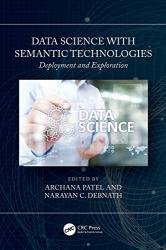 Название: Data Science with Semantic Technologies: Deployment and Exploration
Название: Data Science with Semantic Technologies: Deployment and ExplorationАвтор: Archana Patel, Narayan C. Debnath
Издательство: CRC Press
Год: 2023
Страниц: 246
Язык: английский
Формат: pdf (true)
Размер: 13.2 MB
Gone are the days when data was interlinked with related data by humans and human interpretation was required. Data is no longer just data. It is now considered a Thing or Entity or Concept with meaning, so that a machine not only understands the concept but also extrapolates the way humans do.
Data Science with Semantic Technologies: Deployment and Exploration, the second volume of a two-volume handbook set, provides a roadmap for the deployment of semantic technologies in the field of Data Science and enables the user to create intelligence through these technologies by exploring the opportunities and eradicating the challenges in the current and future time frame. In addition, this book offers the answer to various questions like: What makes a technology semantic as opposed to other approaches to Data Science? What is knowledge data science? How does knowledge data science relate to other fields? This book explores the optimal use of these technologies to provide the highest benefit to the user under one comprehensive source and title.
Two major developments in the history of the World Wide Web meet at the intersection of semantic web services (SWS). One is the quick evolution of web services and the second is the semantic web, both of which are examples of technologies. Greater emphasis is placed in semantic web on the dissemination of more semantically expressive metadata in a collaborative knowledge structure, which allows for the distribution of software agents that wisely exploit the Internet’s offerings. Motivation for web services rely on having vendor-neutral software that can communicate with other systems that may be very different from one another. Using infrastructure as a platform of network with various levels to obtain the goal.
In Machine Learning, a function can be described in one of two main ways: supervised learning or unsupervised learning. The variables in supervised learning can be categorized as explanatory variables and a single or multiple dependent variables. Similar to regression analysis, the goal of this analysis is to establish a causal connection between independent and dependent variables. To use directed data mining methods, it is necessary to already have a good idea of the values of the dependent variable across a substantial portion of the dataset. In unsupervised learning, both independent and dependent variables are given equal weight. In order for supervised learning to work, the target variable must be clearly specified, and a sufficient sample of its possible values must be provided. In most cases of unsupervised learning, either the target variable is unobservable or there is insufficient data to make any meaningful predictions.
As there is no dedicated book available in the market on this topic at this time, this book becomes a unique resource for scholars, researchers, data scientists, professionals, and practitioners. This volume can serve as an important guide toward applications of Data Science with semantic technologies for the upcoming generation.
Скачать Data Science with Semantic Technologies: Deployment and Exploration